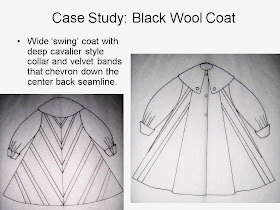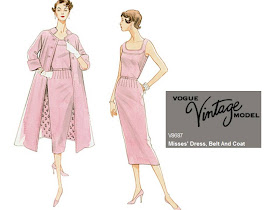
Sewing vintage patterns from the 1940's, 1950's and early 1960's is fun, but getting the right look often requires sewing methods we don't see today. Learning how to sew the styles you like will make it easier to get the look you want. One method is flat lining, and here I want to show a fast and easy way to sew. Our modern fusible interfacings have made traditional flat lining unnecessary. It can have advantages though, and I thought I would share those with you.
Another out dated construction technique is the "S" shaped dart. A straight dart creates at flat curve. In some cases, that is what we want. However, if you are trying to get an hour glass fit to your bodice, than you might want to consider an "S" shaped dart. Glove fitting dresses like those produced by Lanz in the 1950's reveal this dart shape: it hugs the rib cage and curves around the bustline for a smooth body fit.

This light-weight summer cotton dress would wrinkle, and perhaps pull at the seams without this inner construction method. A cool cotton faces the fashion fabric, creating a stronger bodice to the flowing skirt.
FLAT LINING as FACINGBriefly, this method uses a cotton lining that is cut at the same time as the fashion fabric. This is sewn around the neckline and if it is sleeveless, the armholes. This bodice is then turned to the right side. At this point the darts can be sewn and the side seams completed.

This is a fast method that eliminates the need for facing in most cases. The time spent cutting out facing and finishing those edges will be saved.
Open side seams allow for further fitting and adjustments in the future. The top edge at the armhole can be hand sewn to reinforce that upper edge. This method works for both sleeveless styles and bodices with sleeves.
 'S' CURVE DART
'S' CURVE DART The dart will have an smooth seam line up the rib cage, then curve around the bottom of the bust, tapering to a fine line at the end. An 'S' curved bodice dart will create a smooth fitting bodice. It has to be fitted on the body, and should be developed in the pattern stage. However, it can be pinned into place after the bodice is flat lined.
POINT OF BUST This is the bustline center. Do not end darts here because that will make pointed darts. Imagine a Quarter sized circle around the point of bust (it's OK to draw this onto your lining). End the dart point at that circle perimeter line.
FITTING1-BASTE the side darts, using your machine's largest stitch length
2-BASTE the side seams together
3-TRY ON the bodice
4-PIN the back seam together down the seam line
5-PIN in the front bodice darts, shaping them to the rib cage and around the bustline, creating an 'S' curve dart.
6-MARKING: after fitting, remove the bodice for marking. You may mark the dart position on the lining with chalk or pencil before you sew these darts. The two darts should be 'balanced' visually but they may not be exactly the same. As long as the bodice side seams are in the correct location (down your body sides), then they should be fine. No one is exactly the same on both sides of their body, so your darts may reflect that as well.
7-CLIPPING: some 'S' curve darts require clipping so that they can be pressed open. Trim away excess fabric to create a 1/2" seam allowance up the dart. If you have a serger, you can finish these cut seams to prevent unraveling (or zig-zag over the edges).
8-PRESSING: these darts can be pressed open, or towards the front. On this bodice the seams were overlocked together and pressed towards center front. Often the fabric bulk requires that they are pressed open.
-----------------------------------------
HOW TO FLAT LINE as FACING:
STEP-BY-STEPLINING and FASHION FABRIC
On your cutting surface, lay out the fashion fabric 'face down'. Over this, lay on the cotton lining. Smooth out bubbles and align the selvage edges. Pin on pattern (this method will need a pattern for each part, as it doesn't have a center fold). Cut out the pattern.
SEWING 1-Separate the lining and fashion fabrics. Sew the lining fabric shoulder seams and bodice fabric shoulder seams. Press those seams open.
2-On the work surface: lay out the fashion fabric bodice, face up. Over this, lay the lining bodice, face down. The two layers will now be facing each other. Pin together, matching the shoulder seams, then smooth the fabric flat so that all edges meet.
3-SEW around the neckline and armholes. Clip the seam allowances around these curves.
4-TURN the bodices to the right side so the good sides are now facing out, press flat. Match all edges and pin together so that the fabric doesn't shift apart.
5-OVERLOCK unfinished edges, with both layers together: side seams, waistlines and back seams. If you do not have a serger, trim these edges neatly then zig-zag overcast with a wide stitch.
6-FITTING: (see notes above)
7-DARTS: sew bodice darts (see "S" curve dart)
8-SIDE SEAM: this seam will be sewn, then opened flat. The top edge can be reinforced by hand stitching to keep it open. This type of seam will allow for alterations in fit.
9-NECKLINE and ARMHOLE edges can be edge stitched to create a crisp, flat edge.
The bodice is now ready for the skirt to be sewn on to it.
------------------------------------------
I hope you can try this flat lining technique with your next project. I think you will really like the results. If you have had your own experience flat lining, let us know how that worked out.
note: I used a display form for these photos who is sizes smaller than the dresses shown. You will notice the fit isn't correct, try to imagine it is.
 In vintage fashion, a Lilli Ann label brings to mind the San Francisco design house that specialized in drama and fashion flash. It is noted for wonderful wool coats and suits produced following WWII. Although the company history spans several decades, the late 1940's through mid-1960's era are probably the most popular eras for Lilli Ann collectors. I wanted to share one of my Lilli Ann study garments with you. It dates from the early to mid-1950's.
In vintage fashion, a Lilli Ann label brings to mind the San Francisco design house that specialized in drama and fashion flash. It is noted for wonderful wool coats and suits produced following WWII. Although the company history spans several decades, the late 1940's through mid-1960's era are probably the most popular eras for Lilli Ann collectors. I wanted to share one of my Lilli Ann study garments with you. It dates from the early to mid-1950's. Probably the first thing you will notice is the sheer weight of this black wool coat. It is really heavy, in part due to the thick, lush fur blend wool that was produced in post war France for Lilli Ann. The shiny fur guard hairs produce a glimmer that is unmistakable. The silhouette for this coat is a wide 'swing' or 'A Line' cut. Its wide hem is very full, enhanced by pleats in front that fall from the neckline.
Probably the first thing you will notice is the sheer weight of this black wool coat. It is really heavy, in part due to the thick, lush fur blend wool that was produced in post war France for Lilli Ann. The shiny fur guard hairs produce a glimmer that is unmistakable. The silhouette for this coat is a wide 'swing' or 'A Line' cut. Its wide hem is very full, enhanced by pleats in front that fall from the neckline.  To compliment this 'A line' shape, the sleeves have width at the elbow and gather into narrow wrists. These are accented by deep turned back cuffs. An equally wide pilgrim collar can button to the chest.
To compliment this 'A line' shape, the sleeves have width at the elbow and gather into narrow wrists. These are accented by deep turned back cuffs. An equally wide pilgrim collar can button to the chest. When looking to date this coat, I found several Lilli Ann coats of the same textile. Often these have a 'fit and flare' princess seamed silhouette. These two types of coats seem to form the main silhouette selection at Lilli Ann during the early 1950's. Wide collars were popular, and are almost always part of the look. This picture group shows a Lilli Ann coat and others typical of the era.
When looking to date this coat, I found several Lilli Ann coats of the same textile. Often these have a 'fit and flare' princess seamed silhouette. These two types of coats seem to form the main silhouette selection at Lilli Ann during the early 1950's. Wide collars were popular, and are almost always part of the look. This picture group shows a Lilli Ann coat and others typical of the era. The drafts of this coat are drawn to scale and show the coat in detail with its very wide skirt. The front pleats are also apparent in the draft, along with the placement of the velvet appliques.
The drafts of this coat are drawn to scale and show the coat in detail with its very wide skirt. The front pleats are also apparent in the draft, along with the placement of the velvet appliques. 












































